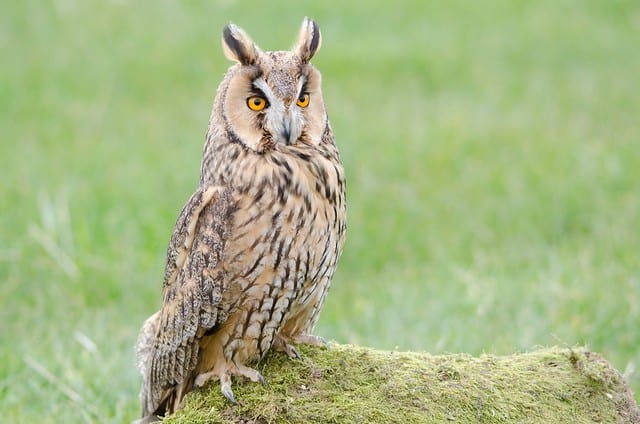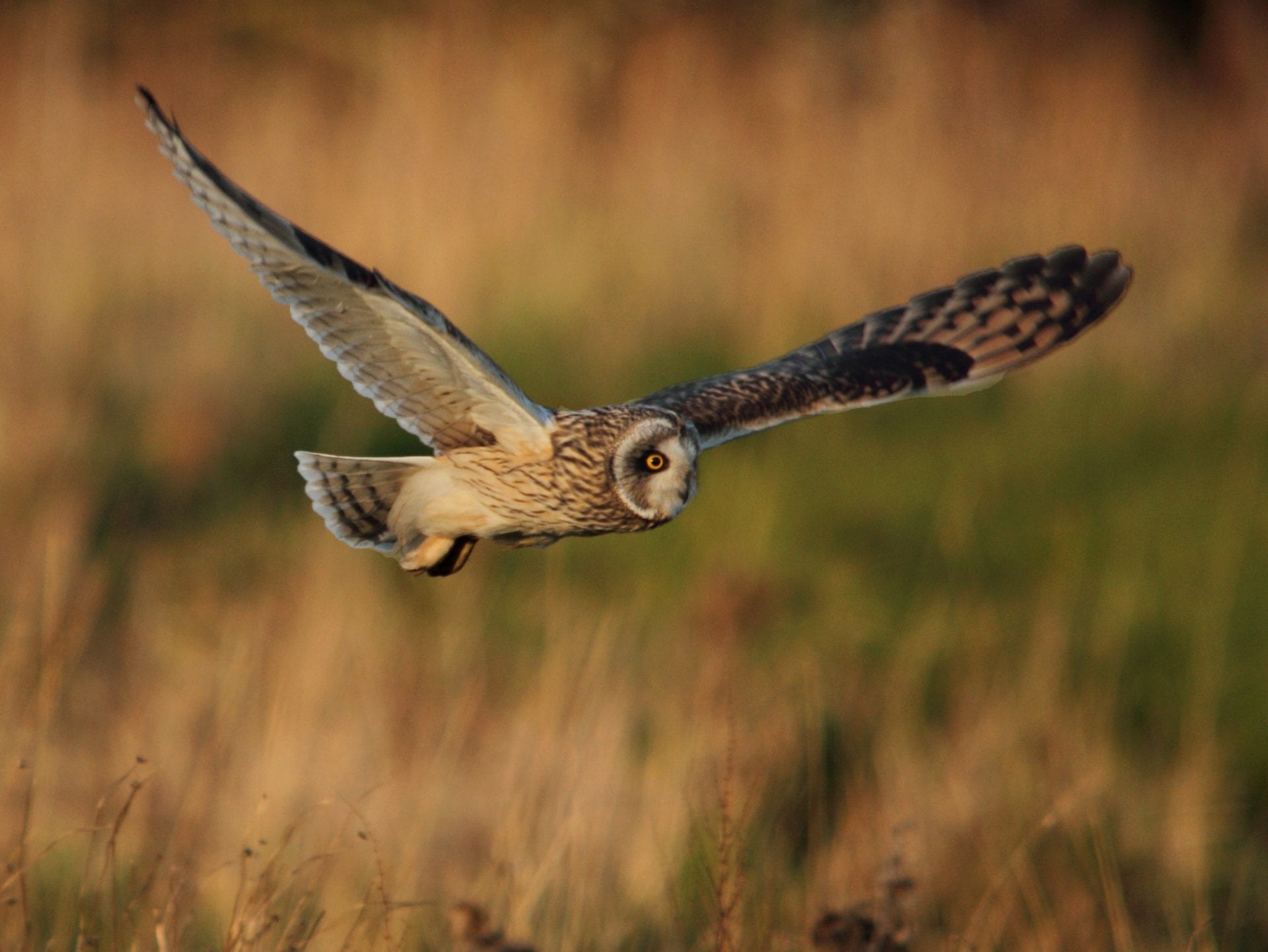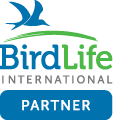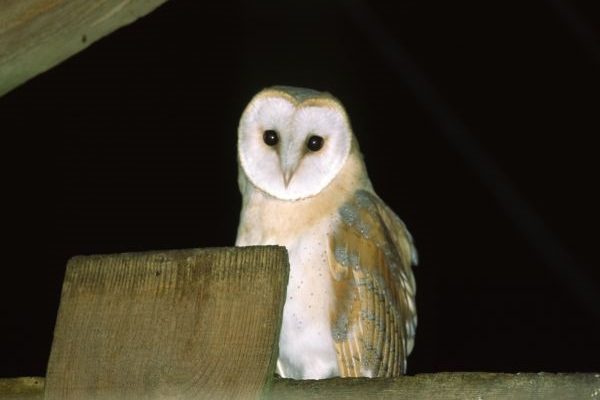
Barn Owl
| Irish Name: | Scréachóg reilige |
| Scientific name: | Tyto alba |
| Bird Family: | Owls |
red
Conservation status
Conservation status
Status
Scarce resident mainly in central and southern Ireland. No longer breeds in large patches of northern, western and eastern Ireland. Red-listed in Ireland due to a significant decline in the breeding population. The European population is currently evaluated as Declining.
Identification
Rarely seen during the day, only active late at night. Most frequently seen flying across road in car head-lights. Appears a ghostly white, with no markings on the underwing - Long-eared owl has a dark comma mark. Given a close view, shows a remarkably intricate patterning on the wings, back and head.
Voice
A loud shriek is most frequently heard.
Diet
Hunts small mammals and frogs. In Ireland, found to be very dependent on Greater White-toothed Shrew with other small mammals forming a much smaller percentage of prey caught.
Breeding
Breeds in ruined buildings, such as castles and to a lesser extent in outbuildings (barns/sheds). Will use special nest boxes. Breeding success heavily dependent on the availability of suitable prey.
Wintering
Largely resident, though young birds will wander in search of new territories.
Monitored by
Blog posts about this bird
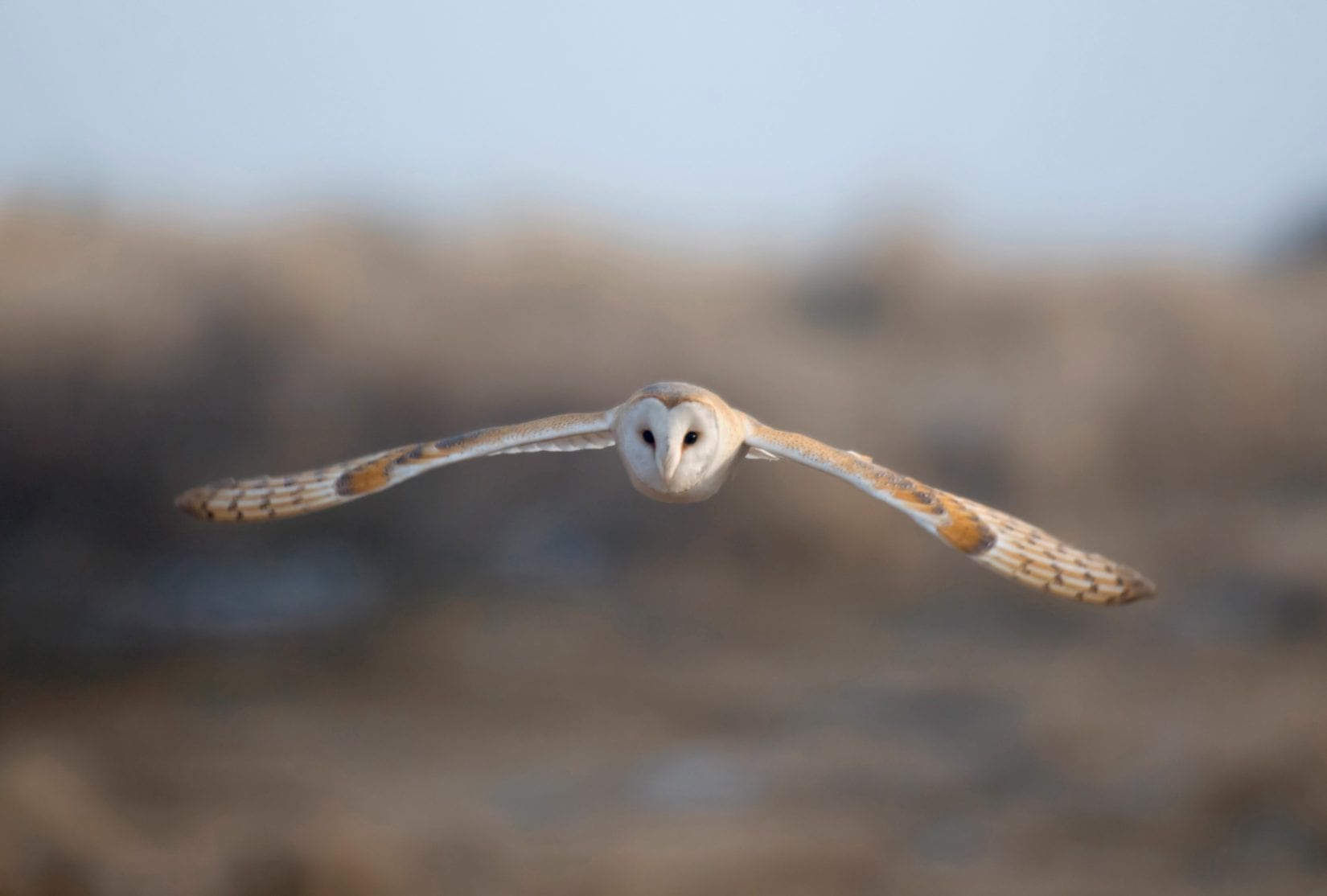
Record number of Barn Owls breed in 2023 thanks to BirdWatch Ireland conservation work
Another Barn Owl breeding season has just come to an end and this one was the best on record, according to the latest figures from the BirdWatch Ireland Raptor Conservation Team.
The breeding productivity and the number of breeding pairs monitored surpasses all previous records.
We are now calling on the public to support our Barn Owl Appeal to help to continue to drive the recovery of this red-listed species.
2023 saw a of milestones for Barn Owls in Ireland. In August, a record 100 Barn Owl nests were recorded in County Cork alone. Additionally, for the first time ever, BirdWatch Ireland recorded a brood of six young Barn Owls in nests in several counties which included Offaly, Kilkenny, Limerick, Wexford and Clare and for the first time ever, we recorded a brood of seven Barn Owls in a nest in Ireland (thanks to the monitoring of Áine Lynch and the Tipperary Barn Owl Team). This season, we also ringed 150 broods, the highest number to date.
 Barn Owl peering out of its nesting hole in an ash tree after dark (Mike Brown)
In recent months, widespread public support coupled with the expertise and dedication of the Raptor Conservation Officers has allowed us to expand our work aimed at supporting this vulnerable species. This included, among other things, giving the public an intimate look into the lives of Barn Owls by livestreaming from a nest in an abandoned cottage in Cork for the first time. Over half a million people tuned into the livestream while the nest was occupied.
Barn Owls are an iconic but unfortunately, red-listed species that face a wide number of threats in Ireland including rodenticide poisoning, road collision and habitat loss. BirdWatch Ireland is working to change their trajectory. Through a wide range of measures, we have been monitoring and supporting vulnerable Barn Owls in a number of counties for over 20 years.
We want to continue our conservation focus on Barn Owls to take advantage of the recent population increases and to ensure that the population continues to recover until its future is secured. We know that our conservation efforts to date have worked, and we are looking for help to support us to continue and expand on these efforts for Barn Owls and biodiversity as a whole. We have received funding through NPWS and several Local Authorities through the Local Biodiversity Action Fund, as well as Dublin Zoo, which has allowed us to undertake much of this work. However, our conservation work for Barn Owls in other Counties and on specific aspects including research and Barn Owl rescues is entirely unfunded, donations made through our Barn Owl Appeal are vital for this work to continue.
Barn Owl peering out of its nesting hole in an ash tree after dark (Mike Brown)
In recent months, widespread public support coupled with the expertise and dedication of the Raptor Conservation Officers has allowed us to expand our work aimed at supporting this vulnerable species. This included, among other things, giving the public an intimate look into the lives of Barn Owls by livestreaming from a nest in an abandoned cottage in Cork for the first time. Over half a million people tuned into the livestream while the nest was occupied.
Barn Owls are an iconic but unfortunately, red-listed species that face a wide number of threats in Ireland including rodenticide poisoning, road collision and habitat loss. BirdWatch Ireland is working to change their trajectory. Through a wide range of measures, we have been monitoring and supporting vulnerable Barn Owls in a number of counties for over 20 years.
We want to continue our conservation focus on Barn Owls to take advantage of the recent population increases and to ensure that the population continues to recover until its future is secured. We know that our conservation efforts to date have worked, and we are looking for help to support us to continue and expand on these efforts for Barn Owls and biodiversity as a whole. We have received funding through NPWS and several Local Authorities through the Local Biodiversity Action Fund, as well as Dublin Zoo, which has allowed us to undertake much of this work. However, our conservation work for Barn Owls in other Counties and on specific aspects including research and Barn Owl rescues is entirely unfunded, donations made through our Barn Owl Appeal are vital for this work to continue.
 Barn Owl (Anna David)
BirdWatch Ireland has built an extensive body of Barn Owl research and with support, we hope to continue to build on this. This research includes undertaking surveys, which help us to better understand the status, distribution and health of populations in different areas of the country, identify nest sites and inform conservation requirements. We also document nest sites and feed this information into a national database of Barn Owl breeding sites. This database, which now includes almost 800 nest sites, provides source information to inform a range of our research and conservation activities.
By monitoring breeding success at a range of Barn Owl nest sites on an annual basis, we can also assess trends in breeding and the health of the population. The survey and monitoring efforts work in close collaboration with a wide range of individuals, groups and BirdWatch Ireland Branches across the country, including the Wexford Barn Owl Project, Wicklow Barn Owl Group, Laois Barn Owl Project, Offaly Barn Owl Conservation Project and the Barn Owl ringing team, to name a few.
We also collaborate with others on research initiatives aimed at increasing our understanding of Barn Owl behaviour and the pressures and threats that they face. Some of these research initiatives are looking at topics such as the extent of exposure to rodenticides in Barn Owls in Ireland, the impacts of major roads on Barn Owls and a European-wide initiative on the effects of weather patterns on Barn Owl hunting and breeding success.
As part of our Barn Owl conservation work, BirdWatch Ireland also manages a range of Barn Owl nest box schemes and this has been a huge success to date. We have recorded Barn Owls breeding in and using over 250 nest boxes to date, with this number increasing on an annual basis.
Other work includes mitigating relevant threats through measures such as nest site improvement, carrying out Barn Owl rescues, ringing Barn Owl chicks and helping to safeguard the future of the species through informing conservation approaches and providing landowner advice.
Those who support our Barn Owl Appeal can help to fund all of this work and more. More information about the Appeal and a donation link can be found here
Barn Owl (Anna David)
BirdWatch Ireland has built an extensive body of Barn Owl research and with support, we hope to continue to build on this. This research includes undertaking surveys, which help us to better understand the status, distribution and health of populations in different areas of the country, identify nest sites and inform conservation requirements. We also document nest sites and feed this information into a national database of Barn Owl breeding sites. This database, which now includes almost 800 nest sites, provides source information to inform a range of our research and conservation activities.
By monitoring breeding success at a range of Barn Owl nest sites on an annual basis, we can also assess trends in breeding and the health of the population. The survey and monitoring efforts work in close collaboration with a wide range of individuals, groups and BirdWatch Ireland Branches across the country, including the Wexford Barn Owl Project, Wicklow Barn Owl Group, Laois Barn Owl Project, Offaly Barn Owl Conservation Project and the Barn Owl ringing team, to name a few.
We also collaborate with others on research initiatives aimed at increasing our understanding of Barn Owl behaviour and the pressures and threats that they face. Some of these research initiatives are looking at topics such as the extent of exposure to rodenticides in Barn Owls in Ireland, the impacts of major roads on Barn Owls and a European-wide initiative on the effects of weather patterns on Barn Owl hunting and breeding success.
As part of our Barn Owl conservation work, BirdWatch Ireland also manages a range of Barn Owl nest box schemes and this has been a huge success to date. We have recorded Barn Owls breeding in and using over 250 nest boxes to date, with this number increasing on an annual basis.
Other work includes mitigating relevant threats through measures such as nest site improvement, carrying out Barn Owl rescues, ringing Barn Owl chicks and helping to safeguard the future of the species through informing conservation approaches and providing landowner advice.
Those who support our Barn Owl Appeal can help to fund all of this work and more. More information about the Appeal and a donation link can be found here
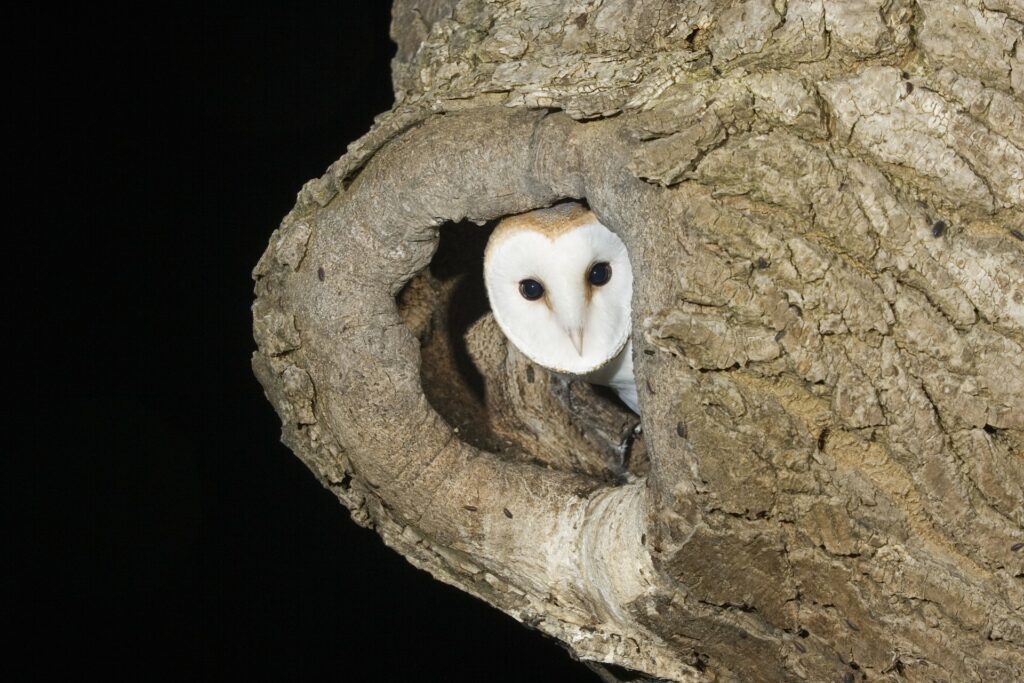 Barn Owl peering out of its nesting hole in an ash tree after dark (Mike Brown)
In recent months, widespread public support coupled with the expertise and dedication of the Raptor Conservation Officers has allowed us to expand our work aimed at supporting this vulnerable species. This included, among other things, giving the public an intimate look into the lives of Barn Owls by livestreaming from a nest in an abandoned cottage in Cork for the first time. Over half a million people tuned into the livestream while the nest was occupied.
Barn Owls are an iconic but unfortunately, red-listed species that face a wide number of threats in Ireland including rodenticide poisoning, road collision and habitat loss. BirdWatch Ireland is working to change their trajectory. Through a wide range of measures, we have been monitoring and supporting vulnerable Barn Owls in a number of counties for over 20 years.
We want to continue our conservation focus on Barn Owls to take advantage of the recent population increases and to ensure that the population continues to recover until its future is secured. We know that our conservation efforts to date have worked, and we are looking for help to support us to continue and expand on these efforts for Barn Owls and biodiversity as a whole. We have received funding through NPWS and several Local Authorities through the Local Biodiversity Action Fund, as well as Dublin Zoo, which has allowed us to undertake much of this work. However, our conservation work for Barn Owls in other Counties and on specific aspects including research and Barn Owl rescues is entirely unfunded, donations made through our Barn Owl Appeal are vital for this work to continue.
Barn Owl peering out of its nesting hole in an ash tree after dark (Mike Brown)
In recent months, widespread public support coupled with the expertise and dedication of the Raptor Conservation Officers has allowed us to expand our work aimed at supporting this vulnerable species. This included, among other things, giving the public an intimate look into the lives of Barn Owls by livestreaming from a nest in an abandoned cottage in Cork for the first time. Over half a million people tuned into the livestream while the nest was occupied.
Barn Owls are an iconic but unfortunately, red-listed species that face a wide number of threats in Ireland including rodenticide poisoning, road collision and habitat loss. BirdWatch Ireland is working to change their trajectory. Through a wide range of measures, we have been monitoring and supporting vulnerable Barn Owls in a number of counties for over 20 years.
We want to continue our conservation focus on Barn Owls to take advantage of the recent population increases and to ensure that the population continues to recover until its future is secured. We know that our conservation efforts to date have worked, and we are looking for help to support us to continue and expand on these efforts for Barn Owls and biodiversity as a whole. We have received funding through NPWS and several Local Authorities through the Local Biodiversity Action Fund, as well as Dublin Zoo, which has allowed us to undertake much of this work. However, our conservation work for Barn Owls in other Counties and on specific aspects including research and Barn Owl rescues is entirely unfunded, donations made through our Barn Owl Appeal are vital for this work to continue.
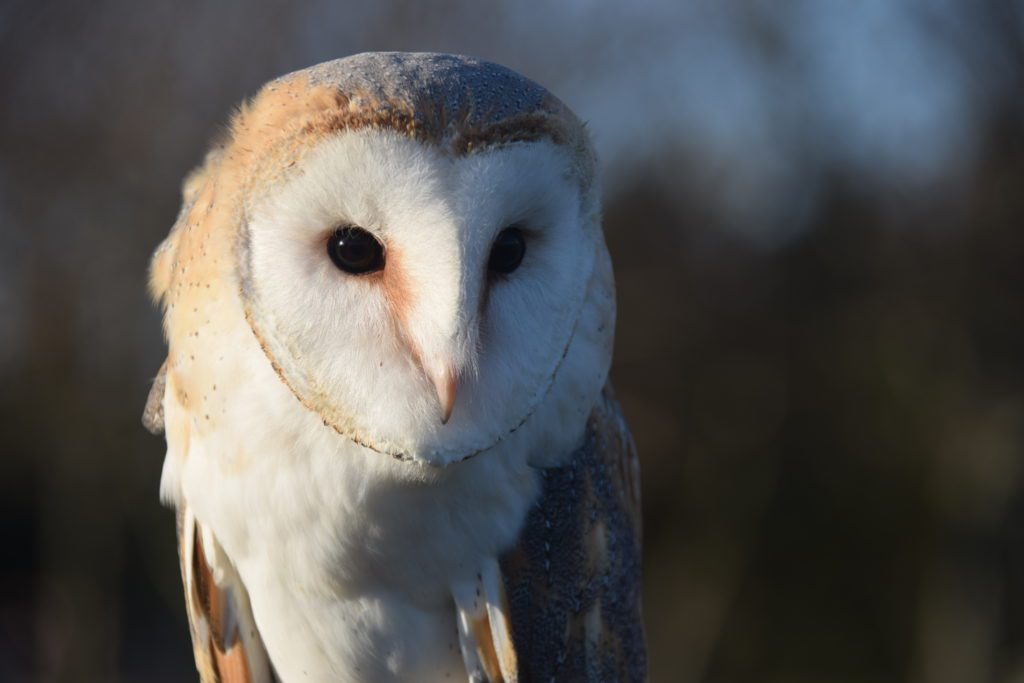 Barn Owl (Anna David)
BirdWatch Ireland has built an extensive body of Barn Owl research and with support, we hope to continue to build on this. This research includes undertaking surveys, which help us to better understand the status, distribution and health of populations in different areas of the country, identify nest sites and inform conservation requirements. We also document nest sites and feed this information into a national database of Barn Owl breeding sites. This database, which now includes almost 800 nest sites, provides source information to inform a range of our research and conservation activities.
By monitoring breeding success at a range of Barn Owl nest sites on an annual basis, we can also assess trends in breeding and the health of the population. The survey and monitoring efforts work in close collaboration with a wide range of individuals, groups and BirdWatch Ireland Branches across the country, including the Wexford Barn Owl Project, Wicklow Barn Owl Group, Laois Barn Owl Project, Offaly Barn Owl Conservation Project and the Barn Owl ringing team, to name a few.
We also collaborate with others on research initiatives aimed at increasing our understanding of Barn Owl behaviour and the pressures and threats that they face. Some of these research initiatives are looking at topics such as the extent of exposure to rodenticides in Barn Owls in Ireland, the impacts of major roads on Barn Owls and a European-wide initiative on the effects of weather patterns on Barn Owl hunting and breeding success.
As part of our Barn Owl conservation work, BirdWatch Ireland also manages a range of Barn Owl nest box schemes and this has been a huge success to date. We have recorded Barn Owls breeding in and using over 250 nest boxes to date, with this number increasing on an annual basis.
Other work includes mitigating relevant threats through measures such as nest site improvement, carrying out Barn Owl rescues, ringing Barn Owl chicks and helping to safeguard the future of the species through informing conservation approaches and providing landowner advice.
Those who support our Barn Owl Appeal can help to fund all of this work and more. More information about the Appeal and a donation link can be found here
Barn Owl (Anna David)
BirdWatch Ireland has built an extensive body of Barn Owl research and with support, we hope to continue to build on this. This research includes undertaking surveys, which help us to better understand the status, distribution and health of populations in different areas of the country, identify nest sites and inform conservation requirements. We also document nest sites and feed this information into a national database of Barn Owl breeding sites. This database, which now includes almost 800 nest sites, provides source information to inform a range of our research and conservation activities.
By monitoring breeding success at a range of Barn Owl nest sites on an annual basis, we can also assess trends in breeding and the health of the population. The survey and monitoring efforts work in close collaboration with a wide range of individuals, groups and BirdWatch Ireland Branches across the country, including the Wexford Barn Owl Project, Wicklow Barn Owl Group, Laois Barn Owl Project, Offaly Barn Owl Conservation Project and the Barn Owl ringing team, to name a few.
We also collaborate with others on research initiatives aimed at increasing our understanding of Barn Owl behaviour and the pressures and threats that they face. Some of these research initiatives are looking at topics such as the extent of exposure to rodenticides in Barn Owls in Ireland, the impacts of major roads on Barn Owls and a European-wide initiative on the effects of weather patterns on Barn Owl hunting and breeding success.
As part of our Barn Owl conservation work, BirdWatch Ireland also manages a range of Barn Owl nest box schemes and this has been a huge success to date. We have recorded Barn Owls breeding in and using over 250 nest boxes to date, with this number increasing on an annual basis.
Other work includes mitigating relevant threats through measures such as nest site improvement, carrying out Barn Owl rescues, ringing Barn Owl chicks and helping to safeguard the future of the species through informing conservation approaches and providing landowner advice.
Those who support our Barn Owl Appeal can help to fund all of this work and more. More information about the Appeal and a donation link can be found here
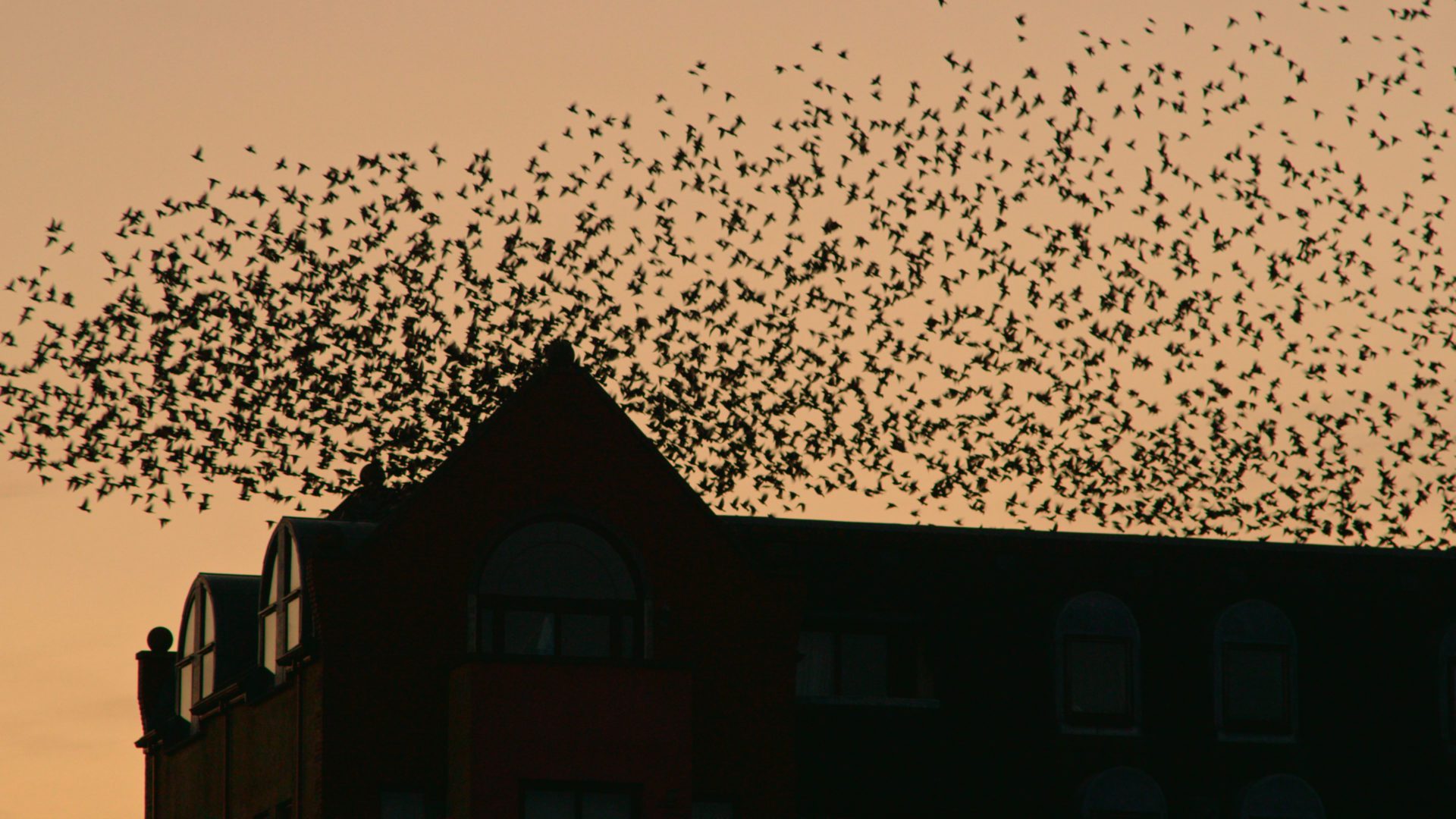
Wildlife in Buildings documentary
[vc_row type="in_container" full_screen_row_position="middle" scene_position="center" text_color="dark" text_align="left" overlay_strength="0.3" shape_divider_position="bottom" shape_type=""][vc_column column_padding="no-extra-padding" column_padding_position="all" background_color_opacity="1" background_hover_color_opacity="1" column_link_target="_self" column_shadow="none" column_border_radius="none" width="1/1" tablet_width_inherit="default" tablet_text_alignment="default" phone_text_alignment="default" column_border_width="none" column_border_style="solid"][vc_column_text]
Certain species are expected residents within our buildings, and for some the association with buildings is apparent even from their names, such as the ‘House Martin’ which builds its mud nest in the apex of the roof of occupied houses, and the ‘Barn Swallow’ which travels from Africa to nest in farmyards throughout the country. The vision of a Barn Owl floating silently from a ruined castle at dusk may seem familiar, but less expected occupants may be a pair of Kestrels nesting in a flower box outside a busy kitchen window, or a female Pine Marten raising her kits in the roof space of an occupied dwelling. Of course, much of the wildlife which use buildings go unnoticed, such as bats roosting in the attic of a house in which the inhabitants beneath remain blissfully unaware of their presence.
Given the importance of buildings for wildlife, changes to the built environment can affect wildlife associated with it. Wildlife in buildings can often be harmed during works due to a lack of awareness of their presence or indeed knowledge of how plan renovations and works in order to avoid disturbance, which is usually always possible. The loss of old stone structures due to demolition, dilapidation or renovation is linked to declines in species such as Barn Owl and Swift, which are dependent on these structures. Modern buildings do not provide the same opportunities for wildlife. However, there is a lot that we can do to improve modern buildings for wildlife to ensure that we continue to make space for nature.
BirdWatch Ireland and CrowCrag Productions in partnership with Laois County Council, Clare County Council and Tipperary County Council and supported by the National Biodiversity Action Plan Fund of the Department of Housing, Local Government and Heritage have produced a nature documentary to celebrate the wildlife which have taken up residence in the built environment, and to showcase some of our most iconic wildlife species which are reliant on buildings for their survival.
John Lusby, BirdWatch Ireland, commented, ‘We wanted to celebrate the importance of buildings for wildlife and to create a better link between our built heritage and our natural heritage – as the two are intertwined. The diversity of species which use buildings, and the ways in which they have adapted to use the built environment, is truly astonishing. As the built environment is constantly changing, we need to make sure that we avoid disturbance to sensitive species and also to continue to provide space for wildlife in buildings, which has benefits for wildlife as well as ourselves. We hope that this feature increases awareness and appreciation of the importance of the built environment for wildlife and provides the necessary information to help conserve some of our most vulnerable and iconic wildlife which are dependent on buildings for their survival’.
Roisin O’Grady, Heritage Officer with Tipperary County Council said ‘We share the world with nature and it can be closer to us than we think. Tipperary County Council is delighted to support this film highlighting the importance of our built environment, heritage or otherwise in providing shelter for such a variety of species, some of which are our most vulnerable. Given the high levels of habitat loss we have experienced over the last number of years it is more important than ever to be aware of how species have adapted to our built environment and how we can support this ‘co-habitation’ and equally important in newer development how we ‘make space’ for nature’.
Congella McGuire, Heritage Officer with Clare County Council commented ‘The Local Authority Heritage Officer Network is delighted to be associated with this Wildlife in Buildings video and the guidance booklet ‘Wildlife in Buildings: linking our built and natural heritage’ both of which were produced with the support of the Local Authorities and National Biodiversity Action Plan Fund’.
The video ‘Wildlife in Buildings: linking our built and natural heritage’ is available to view below or here: https://www.youtube.com/watch?v=5lQt3C8uI5E This video accompanies the guidance booklet on Wildlife in Buildings, which is available here: https://www.kerrycoco.ie/wildlife-in-buildings/
‘Wildlife in Buildings: linking our built and natural heritage’ was produced by BirdWatch Ireland, Kerry County Council and Donegal County Council, with funding from the Department of Housing, Local Government and Heritage through the National Biodiversity Action Plan Fund.
https://www.youtube.com/watch?v=5lQt3C8uI5E&t=782s[/vc_column_text][/vc_column][/vc_row]
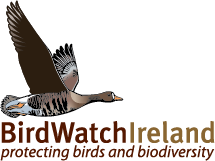
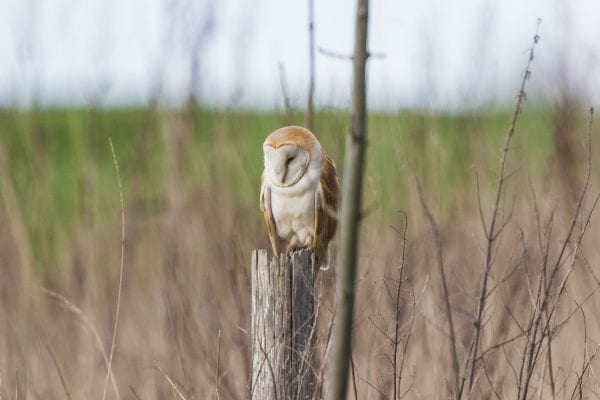
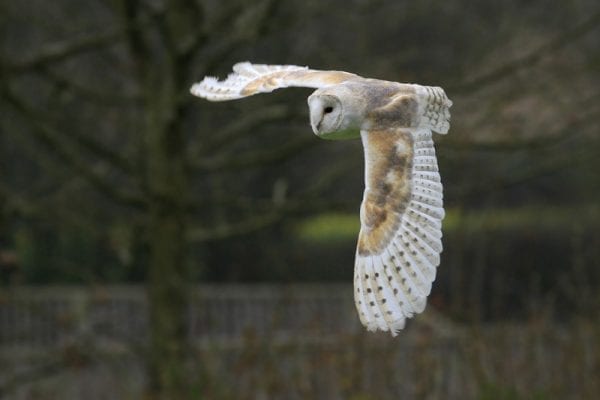
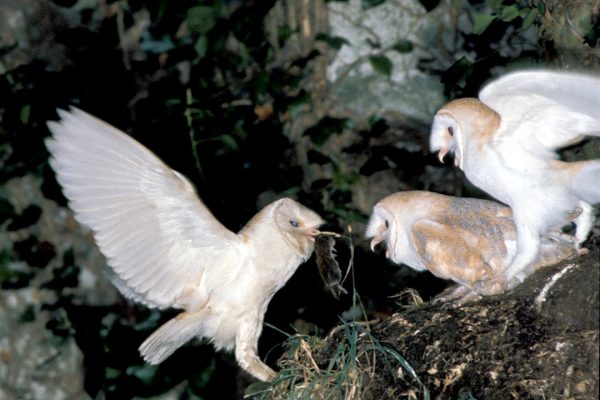
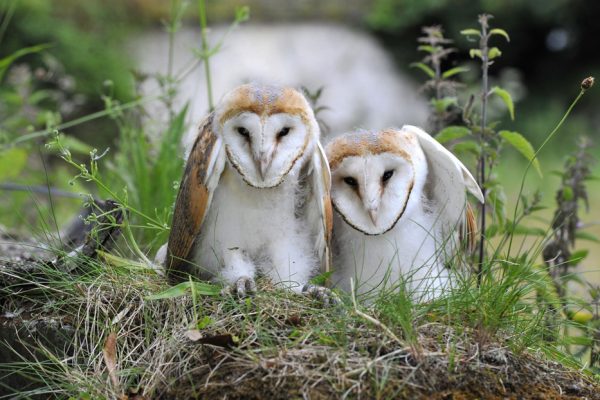
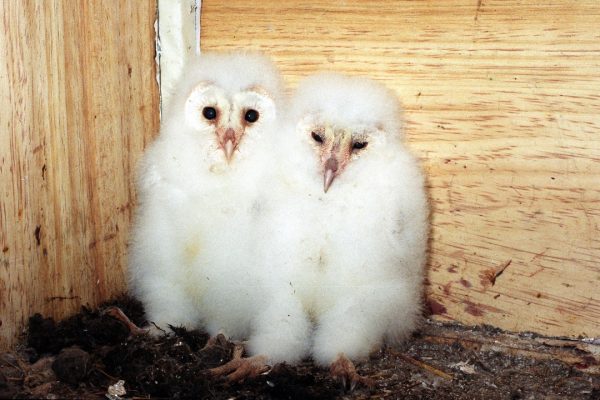
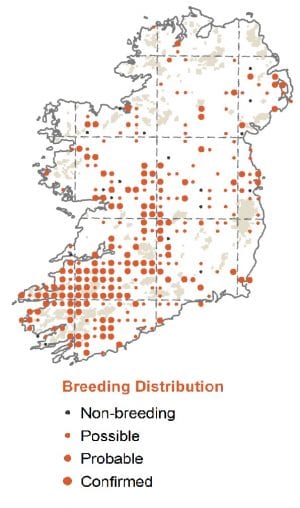
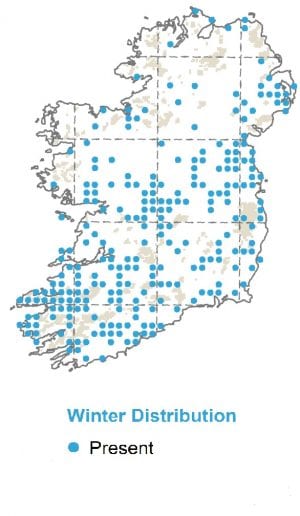
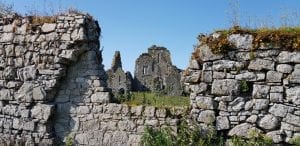 A ruined Abbey which is used by a wide range of wildlife © John Lusby
A ruined Abbey which is used by a wide range of wildlife © John Lusby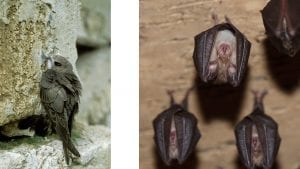 Swift © Artur Tabor, Lesser Horseshoe Bat © Ruth Hanniffy
Swift © Artur Tabor, Lesser Horseshoe Bat © Ruth Hanniffy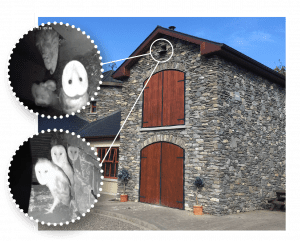 There are many ways we can improve modern buildings for wildlife such as this example, where a purpose built Barn Owl nest site was incorporated in the building
There are many ways we can improve modern buildings for wildlife such as this example, where a purpose built Barn Owl nest site was incorporated in the building 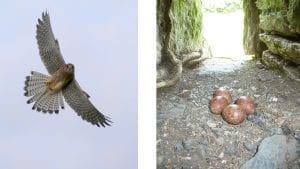 Kestrel in flight © Michael O'Clery, Kestrel nest in castle © John Lusby
Kestrel in flight © Michael O'Clery, Kestrel nest in castle © John Lusby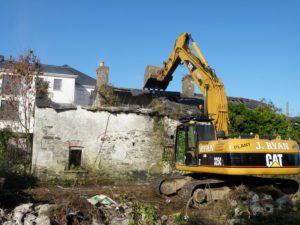 Renovations and other works on buildings can have unintended consequences for wildlife if not planned appropriately © Conor Kelleher
Renovations and other works on buildings can have unintended consequences for wildlife if not planned appropriately © Conor Kelleher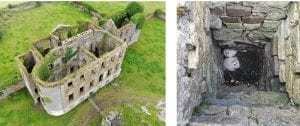 Workhouse in ruins © Michael O'Clery, Barn Owls in chimney nest © John Lusby
Workhouse in ruins © Michael O'Clery, Barn Owls in chimney nest © John Lusby